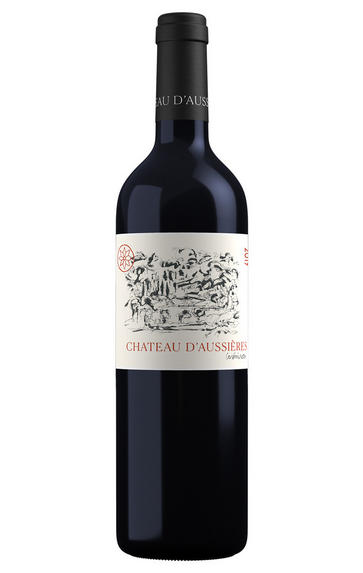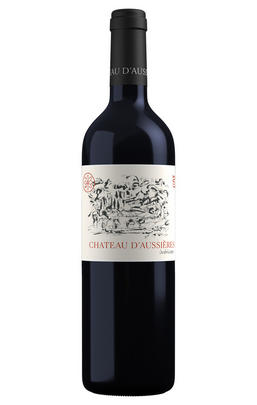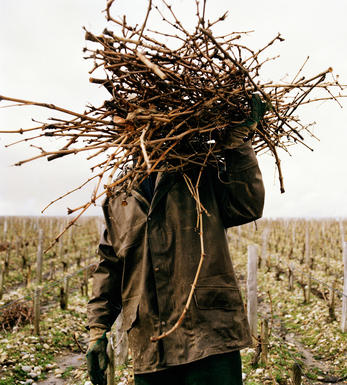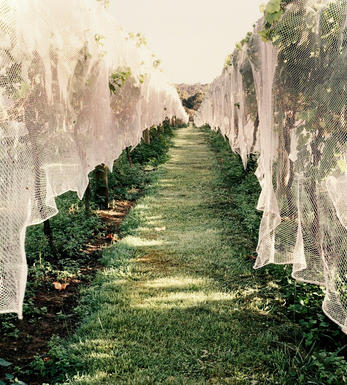
2019 Château d'Aussières, Rouge, Corbières, Languedoc-Roussillon

Critics reviews
The 2019 Chateau d'Aussieres, made from 52% Syrah, 20% Carignan, 19% Mourvedre, and 9% Grenache Noir, is medium to deep garnet-purple in color. It requires a little coaxing to bring out notes of baked black plums, fruitcake, and boysenberry preserves, followed by wafts of tobacco leaf, tar, and sauteed herbs. The full-bodied palate delivers spicy black fruit preserves layers with a chewy texture and savory finish.
Drink now to 2031
Lisa Perrotti-Brown, The Wine Independent (August 2023)
Plenty of graceful black and red fruits, this is an impressively balanced wine from a warm vintage. Turmeric and smoked cumin kick things off, emphasising tight tannins that will soften over the next few years, before everything softens and opens through the mid palate to show a burst of baked raspberry, incense and rosemary spices, orange peel, plenty of juice. First time for the 167ha Domaine d'Aussières on the Place (or rather not in exclusivity with DBR Lafite). Director Jean de Roquefeuille (ex Rieussec), working alongside the group winemaker Olivier Tregoat.
Drink 2024 - 2036
Jane Anson, Inside Bordeaux (August 2023)
Blackcurrants, slate, crushed stone and berries with hints of chocolate. Medium-bodied, bright and racy. Vivid at the end. A blend of Syrah, Carignan, Mourvèdre and Grenache.
Drink now
James Suckling, JamesSuckling.com (August 2023)
The 2019 Château d'Aussières is blended from 52% Syrah with 20% carbonically macerated Carignan, 19% Mourvèdre and 9% Grenache. It’s another dark red wine with harmonious, complex aromas which combine blackcurrant fruit (typical, says the Aussières consultant Matthieu Dubernet, of Fontfroide Syrah) with wildflower and hillside pine forest scents. The palate is surprisingly light and elegant with a sense of proportion and harmony; there’s no shortage of fruit density, though. It’s a more approachable wine at this stage than the 2018.
Drink to 2030
Andrew Jefford, Decanter (August 2023)
About this WINE

Chateau d'Aussieres
Domaines Barons de Rothschild (Lafite) and Domaines Listel joined forces to revitalize one of the oldest and most beautiful wine-making estates in the Languedoc, Château d'Aussières.
Acquired in 1999 by Domaines Barons de Rothschild (Lafite), the 550 hectare estate has undergone a vast rehabilitation programme. 167 hectares of vines have been replanted with carefully selected traditional Languedoc grape varieties. The estate buildings were restored at the same time and a new winery installed in the old cellars, in the heart of the vineyard. State-of-the-art equipment and technology are seamlessly married to time-tested methods in the production of the wine.
The 167 hectare vineyard is situated close to Narbonne, in the Corbières wine appellation, at the heart of the “Fontfroide terroir”. Two thirds of the vineyard are in the Corbières AOC appellation (grape varieties: Syrah, Mourvèdre, Grenache, Carignan, Cinsault) and one third in the Vin de Pays d’Oc appellation (Chardonnay, Merlot, Cabernet Sauvignon, Cabernet Franc, Petit Verdot).
The vineyard is managed following traditional Corbières growing practices with 4400 trellised vine plants per hectare. As the vineyard is very young, yields are deliberately kept low (about 35hl/ha) to promote good root system development and vine health while ensuring a high quality crop.
40% of Château d'Aussières is aged in oak barrels (half of which are new) and bottled after 12 to 16 months ageing. 20% of the Blason d'Aussières is aged in barrels and bottled after 12 months ageing. The barrels are supplied by the Domaines’ Cooperage in Pauillac. Aussières Red is aged in vats and bottled the year after the harvest. The Aussières White is bottled in the spring after the harvest in order to preserve its freshness.

Corbieres
A vast (ie the largest in Languedoc) and consequently oft-misunderstood appellation, Corbières covers over 12,000 hectares in the Pyrenean foot-hills, with a variety of soils and micro-climatic influences. In recognition of this diversity, the appellation was subdivided in the 1990s into 11 so-called terroirs, including Montagne d'Alaric, Lagrasse, Lézignan, Boutenac, Fontfroide, Sigean, Durban, Saint-Victor, Quéribus, Termenès and Serviès. The central limestone vineyards of Boutenac are deemed to be the best of these, and thus have their own sub-appellation.
On a terrain this extensive and this varied, four separate topographical zones may be identified: the one in the west, exposed to the cooling Atlantic influence; the coastal zone to the east, influenced by the warm Mediterranean climate; a central mountainous zone in which the Fitou appellation is also located; further north, based around the Montagne d'Alaric, the landlocked enclave which produces wines not dissimilar to those in the neighbouring Minervois.
Corbières wines have had a somewhat undeserved reputation for rusticity, and quality can admittedly still be somewhat mixed. The best examples, however, combine the concentration and herbal richness that can come from old-vine Carignan, especially when married to the so-called 'improving varieties' such as Syrah, Grenache and Mourvèdre.


Buying options
Add to wishlist
Description
The 2019 Chateau d'Aussieres, made from 52% Syrah, 20% Carignan, 19% Mourvedre, and 9% Grenache Noir, is medium to deep garnet-purple in color. It requires a little coaxing to bring out notes of baked black plums, fruitcake, and boysenberry preserves, followed by wafts of tobacco leaf, tar, and sauteed herbs. The full-bodied palate delivers spicy black fruit preserves layers with a chewy texture and savory finish.
Drink now to 2031
Lisa Perrotti-Brown, The Wine Independent (August 2023)
wine at a glance
Delivery and quality guarantee